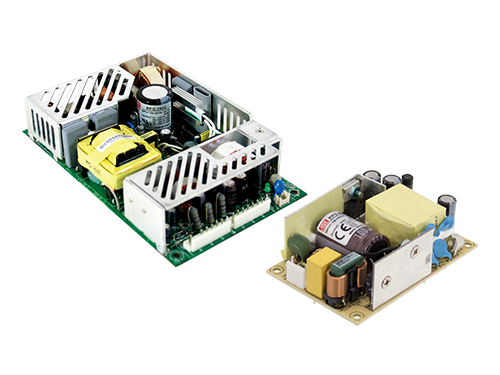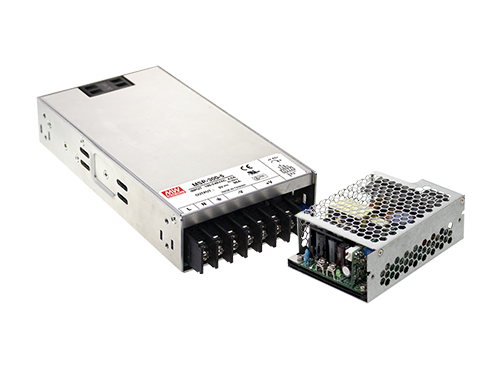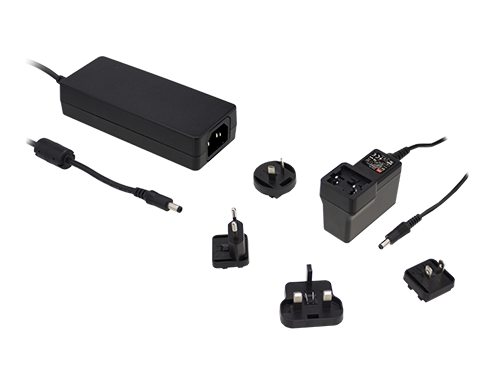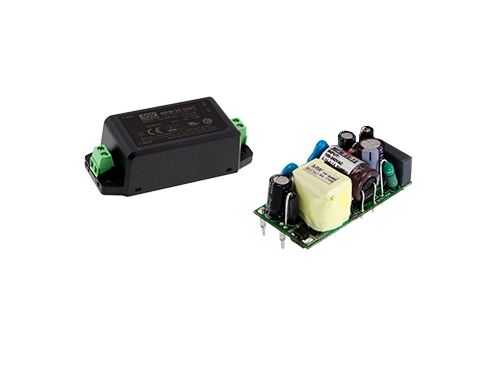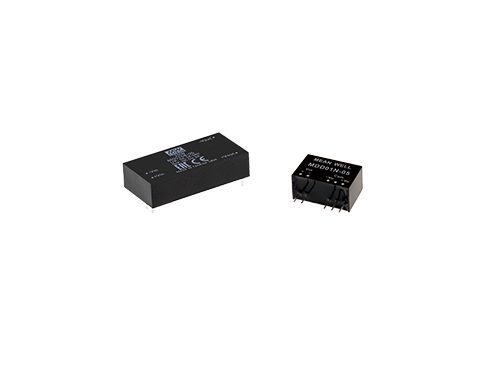Major Characteristics for Medical Power Supply
Medical environments are known for its omnipresent risk for both vulnerable and healthy people. To ensure the utmost safety, the design of Medical Power Supplies is monitored by the strictest quality exigences and safety regulations.
As the heart of any electrical medical device, the medical power supplies must comply with the highest standards of performance, safety (IEC 60601) and reliability. Criteria such as MOPP, MOOP, low leakage current, EMC must be taken into consideration during the development stage.
As a result, Medical Power Supplies are equipped with higher levels of insulation and superior EMC performance, and we can distinguish one medically approved Power Supply from other electronics components by its exigent protection level, its high reliability and its extended life cycle of components.
MEAN WELL Medical Power Supplies
MEAN WELL is the global leading manufacturer of Standard Power Supplies in the market. With over 40 years of experience in the development and production of power supplies, MEAN WELL offers the widest range of high-quality Medical Power Supplies in 6 categories as below.
How to choose your Medical Power Supply?
As the keystone of one medical system, it is extremely important to select a safe and reliable Medical Power Supply. To choose the most suitable Medical Power Supply for the Medical system, the R&D engineers are strongly suggested to take, as guideline of selection, the listed criteria below into consideration
A. Electrical requirements
The input voltage range and required power should be defined for the application, as well as its output voltage and the needed current to power the application:
- Input voltage range: the most common input source is an AC source, and the range requirement is related to the destined market of the end devices. In the case of multiple market regions of the Medical system, it is strongly recommended to choose a Medical Power Supply with input voltage range covering at least the range of 100VAC to 240VAC.
- Power requirement: the required power depends mainly on the end device. It is suggested to keep in mind the derating caused by the unfavorable working temperature, as well as the potential peak current.
Output voltage and current: according to the design of the Medical system, some systems demand a constant current output while others need constant voltage. The R&D engineers should choose an adequate Medical Power Supply, with the right level and type of DC output, based on the design of the application.
B. Regulations
As each market territory and each application field imposes its own safety regulations on the end devices, it is crucial to understand which certifications are mandatory for the application and its target market(s) during the development process.
For instance, home healthcare devices are required to meet the standards of IEC 60601-1-11, while for equipment not directly in contact with the patient, IEC 62368 might still give one the possibility to get a medical certification for medical test and measurement equipment on a system level.
Meanwhile, each country adopts its specific safety standards for the application field (e.g. UL ANSI/AAMI ES60601-1 for the US, EN 60601-1 for EU countries, CAN/CSA-C22 3rd edition for Canada…etc.
C. Installation Method
The installation of the PSU can be either internally or externally depending on how the Power Supply is designed to be integrated into the system.
External solution:
Internal solution:
- Medical Enclosed type: PSU with plastic or metal case.
- Medical PCB type: A PCB populated with components which from the power supply. Normally this solution is without any mechanical protection such as a housing. For this reason, normally installed inside an application and not touchable by the user.
- Medical On board or Medical PCB mount: PSU designed to fit on a PCB. It can be either “open frame” or “encapsulated”. The second type is potted with compound to provide protection against external elements (e.g. moisture, corrosive elements, shock, vibration…etc.).
D. Other requirements
Medical systems are regulated with extremely vigorous exigences. On top of the above criteria, it is also important to verify that the other specific requirements are met:
- Class: Class I or class II
- Heat dissipation: Forced air cooling (with fan) or Passive cooling (without fan)
- Level of protection required: 2 x MOOP, 2 x MOPP
- Leakage current
- Overload protection: Constant Current Limiting or Hiccup mode
- Remote on/off function
- Current sharing function
- Parallel function
- …
Specific Requirements for Medical Power Supplies
I. IEC 60601-1:
Defined by the world known International Electrotechnical Commission (IEC), IEC 60601-1 is a series of technical standards destined to ensure the safety and performance of electrical equipment in the medical industry. On one hand, some digression from the IEC 60601-1 standards exists. For example, EN 60601-1 for Europe and ES 60601-1 for the US market which are harmonized with the IEC standards. One the other hand, there are also some “collateral” standards to IEC 60601-1; such as IEC 60601-1-2 which is the 4th edition of collateral EMC standards to IEC 60601-1.
II. MOOP and MOPP
In the medical environment, risk is constantly present for patient and/or operator of a medical device. Aiming to protect both groups from electrical medical devices, MOOP and MOPP are introduced to monitor the level of insulation.
- MOOP stands for Means of Operator Protection. This category is related to electronic devices which are handled by trained operators, and do not come into direct contact with the patient. The medical device with 2 x MOOP has an isolation of 3000V AC isolation.
- MOPP, on the other hand, is the Means of Patient Protection; all electronic devices with direct physical contact with patients must meet stricter standards and require a double isolation between input and output.
Presuming that patients are vulnerable; MOPP standards are specially designed to protect them from any potential electric shock. In the design, MOPP requires the medical devices to have two separate insulation barriers.
Therefore, devices are MOOP and MOPP classified depending on the type of contact with patients and operators.
| Classification | Required Isolation | Required Creepage | Requirement Insulation |
| MOOP | 1500V AC | 2.5mm | – |
| 2 x MOOP | 3000V AC | 5mm | Reinforced |
| MOPP | 1500V AC | 5mm | – |
| 2 x MOPP | 4000V AC | 8mm | Reinforced |
1 MOOP and MOPP under IEC60601-1 are different in the levels of isolation, creepage, insulation.
III. Low leakage current
The essential use of medical equipment is on the human body, therefore the chance and duration of contact with this equipment is higher and longer. Having electric current running throughout the body can be extremely dangerous and might even result in death. For example, a current as low as 40mA could already be fatal to a healthy person, while a weakened person’s tolerance is even lower.
To protect all people in contact with the devices from the electric shock, medical power supplies must meet strict requirements in terms of leakage current. While Applied Parts (AP) indicate the parts of a Medical device or a Medical system which, during normal use, come into direct physical contact with a patient. The standards of IEC60601-1 give a clear definition of the acceptable values of leakage current for each classification of Applied Parts (AP), and the classifications are further divided into 2 categories: “NC” for normal condition and “SFC” for Single fault condition.
Leakage Current |
Type B | Type BF | Type CF | |||
| NC | SFC | NC | SFC | NC | SFC | |
| Earth Leakage Current | 5mA | 10mA | 5mA | 10mA | 5mA | 10mA |
| Enclosure Leakage Current | 100µA | 500µA | 100µA | 500µA | 100µA | 500µA |
| Patient Leakage Current | 100µA | 500µA | 100µA | 500µA | 10µA | 50µA |
2 Different Leakage Current limits defined by IEC60601-1 according to the medical environment: Type B, Type BF, Type CF
IV. Classification of medical environment
Just like medical power supplies, end systems in medical environments are also regulated by strict isolation and leakage current requirements.
Depending on the type of physical contact between patient and medical device, there are three main classification types of Applied Parts (AP) in the medical environment: Type B, Type BF, Type CF.
- Type B (Body)
Devices with no direct physical contact with patients. Examples: medical bed, medical laser…etc. - Type BF (Body Float)
Devices with physical contact with patients and might present risk in the case of device failure. Examples: Incubators, diagnostic equipment, etc. - Type CF (Cardiac Float)
Direct contact to the patient’s heart, risk of injury or death in the event of device failure. Examples: Defibrillators, heart-lung machines, etc.
Note: Medical power supplies for type BF & CF devices are designed to meet 2 x MOPP
V. EMC standard and limits
Malfunction induced by electromagnetic or interference could be fatal when it comes to life-saving devices. The EMC standards EN 55011 for electromagnetic interference and IEC 60601-1-2 with reference and electromagnetic immunity must be considered.
The 4th edition of the IEC-60601-1 standard on EMC is much more vigorous with electromagnetic immunity than the previous edition. Medical devices must now be immune to HF fields up to 2.7GHz, which represent an increase by 0.2GHz. To prevent damage caused by electrostatic discharge, the limits have also been increased accordingly. For contact discharge, the level has been increased from 6 to 8kV. For air discharge, it has been increased from 8 to 15kV compared to the previous edition.
VI. EU Medical Device regulation (MDR)
The European Union Medical Device Regulation (MDR) published 2017, will soon replace the current Medical Device Directive (MDD) (93/42/EEC) and the EU’s Directive on active implantable medical devices (90/385/EEC). All development engineers and manufacturers related to Medical Devices within Europe will need to follow the Medical Device Regulation of 2017 published by European Parliament.
VII. ISO 13485
ISO 13485 is the standard for the quality management system for medical devices. The requirements are destined to organizations involved in the design, production, storage, installation and maintenance of medical devices and other related services.
Learn more about Medical Power Supplies
Explore our blog for insightful technical notes about Medical Power Applications.
Got questions?
Look at the section below to find the most frequently asked questions (with answers)
we received in Medical Power Applications.
The GTIN number can be found directly on the www.meanwell.com:

Internally, IRM series has the following AC fuses, which are implemented on AC/L input:
| IRM-01/02/03 | T1A/L300V |
| IRM-05/10/15/20/30 | T2A/L300V |
| IRM-45/60 | T2.5A/L300V |
| IRM-90 | T3.15A/L300V |
Yes, MEAN WELL products are registered in SCIP. To get such information for specific power supply, please follow the steps below:
- Go to https://echa.europa.eu/en/scip-database
- Under SEARCH option, choose „Article Identity” and write down model name e.g. RSP-1600.
- As “Identifier type (optional)”, please chose “Other”
- Click “Search” button

The declaration of Five PBT TSCA Conformity can be found on the last page of Installation Manual e.g. below:

Find the latest news in the MEAN WELL APP


You can follow us on LinkedIn:

Go to:
https://www.linkedin.com/company/meanwell-europe-b-v-/
1. Click follow
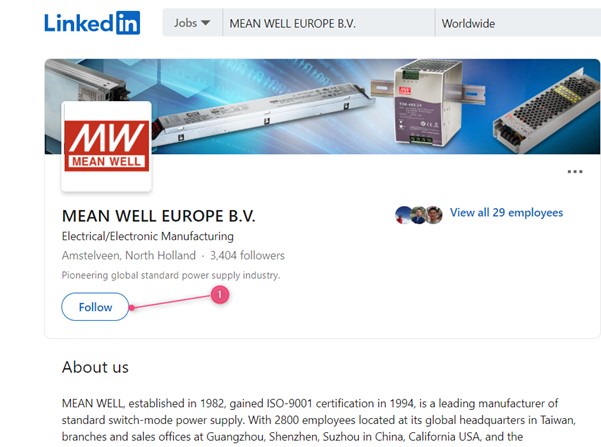
And you could install our APP see our FAQ “How to subscribe to MEAN WELL’s newsletter?”
MEAN WELL’s distributor information can be found on Distributor Network-MEAN WELL Switching Power Supply Manufacturer
- Click on the region that you are located
- Select the country you are in
- Click on the search button
- Scroll down to see our local distribution channels
- Look for the distributor with a tick for the product group that you are looking for

MEAN WELL has the largest distribution network for serving your small and medium demand Power Supplies. You can find all MEAN WELL’s distribution channels on Distributor Network-MEAN WELL Switching Power Supply Manufacturer.
OEM’s which have no sales channel for MEAN WELL products yet can contact us via the “Contact Us” form on this website.
MEAN WELL’s discontinued product schedule and End of Life products are normally updated 2 times per year, in January and in July and are published on www.meanwell.com. See FAQ “Where can I find MEAN WELL’s discontinued product schedule and End of Life information? “
The normal procedure for E.O.L. is:
- The product or series is announced in the Discontinued product list in January or July and announced as NRND (Not Recommend for New Design)
- 6 months later the lead time of the product or series will increase +30 days, the price will increase as well.
- Another 6 months later, the lead time will increase another +30 days (so + 60day compared to the original lead time), the price will increase again.
- Another 6 months later, the lead time will increase another +30day (so +90 days compared to the original lead time) and the price will increase again and additionally there will be a MOQ of 200pcs (and steps of 100 for higher quantities)
- After another 6 months the last buy is announced on the website. This will be the last opportunity to place an order for this product or series.
In total MEAN WELL’s End of Life, procedure will take 2 years. However, there are situations for instance that certification is expired, or some components can no longer be obtained by the market which will force to accelerate the EOL schedule. Therefore, it is always highly recommended from the moment that a product is on the discontinued list to design in one of our new generation products. If need any advice to this, please use the “Contact Us” function on this website.
MEAN WELL’s discontinued product schedule and End of Life products are normally updated 2 times per year, in January and in July. To see the full list, go to www.meanwell.com
1. Click on products
2. Click on Discontinued products for the schedule for the EOL schedule
Click on EOL for the MEAN WELL products which are End Of Life

You can use the “Contact Us” function on this website
MEAN WELL’s website provides you all the basic information about our Power Supplies. This includes company news, product announcements, ISO certificates, Specifications, test report, Certificates, ROHS declarations, Reach declarations and many more.
MEAN WELL’s products can be found on www.meanwell.com
1. Click on products and select the product category

Or in case you already have a part number, you can use the search function on the website:
2. Use the search function on the website to find the right product
3. Fill in the series number in the search field (do not include the last extensions such as -12 in XLG-150-12)
4. Click the search button

5. Click on the PDF icon to open the specification

MEAN WELL has several charger products, and we suggest choosing them first. Chargers would be more suitable since they are designed for charging applications. Safety and approvals should be taken into account based on the final application. If you are unable to find a proper model in our charger series, our LED CC models can be used as charger. Please choose suitable products after confirming the current and voltage specification on the datasheet of the battery.
All MEAN WELL chargers are preset for lead-acid batteries. For other products that can customize the charging curve (such as ENC / NPB series), customers can customize their charging curve depending on the charging and discharging characteristics of batteries. If you have other requirements, please use the contact us function on this website.
MEAN WELL has launched ENC, HEP-600C, GC, PA, PB, RPB and RCB series for battery charge applications (30~1000W). However, if these models cannot fulfill your requirements, there is an alternative solution. Power supplies with constant current limiting as overload protection are suggested. Charge current varies in battery percentage (full or flat), there is high possibility to trigger overload protection when battery is low, those with overload protection as hiccup or shutdown will stop charging the battery in low battery condition. Yet, using a power supply as charging purpose is considered as overload usage, modification is required. Please Contact Us for the request.
MEAN WELL’s Step files/ 3D files can be found on www.meanwell.com
- Use the search function on the website to find the right product
- Fill in the series number in the search field (do not include the last extensions such as -12 in XLG-150-12)
- Click the search button
- Click on the PDF icon to open the specification

- Click on 3D OUTLINE
- Click on the model XLG-150-3D to download the step file.

Yes, for power supplies certified >2000m please read the “note” in the spec.
In general, for unpotted models, a derating of 5°C/1000m has to be applied and for potted models, a derating of 3.5°C/1000m has to be applied.
For example LRS-75-24:
The datasheet shows:

The Note. 7 shows:

At 5000m the derating curve will need to move 15°C following the arrow (1)
At full load the maximum operating temperature at 5000m will be 35°C shown at (2)

Cooling fans have a relatively shorter lifetime (typical MTTF, Mean Time To Failure, of around 5,000-100,000 hours) compared with other components of power supply. As a result, changing operating method of the fans can extend the operation hours. The most common control schemes are shown as below:nnTemperature control: if the internal temperature of a power supply, detected by a temperature sensor, is over the threshold, the fan will start working at full speed, whereas, if the internal temperature is less than the set threshold, the fan will stop working or run at half speed. In addition, cooling fans in some power supplies are controlled by a non-linear control method whereby fan speed can be changed with different internal temperatures synchronously.nLoad control: if the loading of a power supply is over the threshold, the fan will start working at full speed, whereas, if the loading is less than the set threshold, the fan will stop working or run at half speed.
During safety verification process, the agency will use a stricter standard ±10% (IEC 62368 uses +10%, -10% for the product with AC input rated) of the input voltage range labeled on the power supply to conduct the test. So, operating at the wider input voltage range as specified on the spec. sheet should be fine. The narrower range of input voltage labeled on the power supply is to fulfill the test standard of safety regulation and make sure that users insert input voltage correctly.
PMBus full name is Power Management Bus is an open standard for digital power management. The physical layer is based on I2C, and PM Bus had a set of commands that specifically design for power supply industry. More information can be found in https://pmbus.org/
MEAN WELL Rack Power and intelligent power supply and chargers have optional PMBus solution for example: PHP-3500 and HEP-1000 further the RCP/RSP-1600, UHP-2500 and DPU-3200 have this optional available.
A Controller Area Network (CAN Bus) is a bus standard initially developed for vehicle designed to allow multi-master with priority control without a host computer. The latest version is CAN 2.0 which consists of part A and part B. CAN 2.0A is for standard format with 11-bit identifier, and CAN 2.0B is for extended format with 20-bit identifier. CAN Bus is widely used in Automotive and industrial automation. There are not only 1 but many higher layer protocol such as CANopen, DeviceNet and more.
MEAN WELL CAN Bus product support CAN 2.0B (ISO-11898) with baud rate 250Kbps
MEAN WELL offers optionally CAN bus for PHP-3500, HEP-1000, RCP/RSP-1600, UHP-2500 and DRP/DPU-3200 and DBR/DBU-3200.
Most MEAN WELL power supplies are certified to be operated till 2000m. For some models the certification is valid for a higher altitude, this will be shown on the first page of the power supply under features (1)(2).
Please note that derating is needed at an altitude above 2000m. See FAQ “Do I need to derate my power supply when I used it over 2000m?”

MEAN WELL’s specification shows the absolute values which were verified during design quality verification tests. Those condition are guaranteed by manufacture from quality and warranty perspectives.
When certifying a power supply according to a certain norm, there is normally a requirement described in this standard a certain tolerance which must be considered. (See also FAQ: Why Is The Input Voltage On The Label Different From The Input Voltage In The Spec? For Example, The Specification Shows Is 88~264 VAC While The Label On The Power Supply Says That It Is 100~240VAC?)
The specification shows what is possible, the report and label of the power supply shows what is approved by the certifying body according to the standards.
Besides the difference due to tolerance there might also be another reason why the specification and label/test report show a different temperature. For example, if the power supply needs to be derated at a low voltage input such as 100VAC, the label and test report might show the max temperature at full load based on this low input.
Different standards might have different tolerance requirements and different ranges this could mean that the most conservative value, or multiple values will show up on the label of the power supply.
MEAN WELL’s component self-heating can be found on www.meanwell.com
1. Use the search function on the website to find the right product
2. Fill in the series number in the search field (do not include the last extensions such as -12 in XLG-150-12)
3. Click the search button
4. Click on the PDF icon to open the specification

5. Click on report

6. Click on the model and scroll down:

7. The temperature of the critical component can be found in the chapter Reliability Test under item 1 Temperature Rise Test

For more details about the component type for each position, please use the Contact Us function on this website.
MEAN WELL’s MTBF can be found on www.meanwell.com
1. Use the search function on the website to find the right product
2. Fill in the series number in the search field (do not include the last 3. extensions such as -12 in XLG-150-12)
3. Click the search button
4. Click on the PDF icon to open the specification

Scroll down in the specification to the bottom of the second page

5. Find the MTBF value in under others:

MEAN WELL’s capacitor lifecycle calculation can be found on www.meanwell.com
1. Use the search function on the website to find the right product
2. Fill in the series number in the search field (do not include the last extensions such as -12 in XLG-150-12)
3. Click the search button
4. Click on the PDF icon to open the specification

5. Click on report

6. Click on the model and scroll down:

7. The Capacitor life cycle calculation is shown on the last page of the report in the chapter Reliability test

The Capacitor life cycle calculation is considered as the key indicator for the lifetime of the power supply. Please refer to the test report of the power supply on www.meanwell.com for the capacitor life cycle calculation.
As a rule of thumb, every 10dC increase the lifetime will be cut in half and vice versa for every 10dC decrease in temperature.

In the above example, if the power supply is used at 75dC at Ta 40dC, the estimated lifetime would be 2*104095 Hrs ~200K hrs.
In MEAN WELL’s specification you can find 2 derating curves, in below example the 300W open frame power supply: EPP-300
- The Derating Curve with the Ambient Temperature vs. Load
- The Derating Curve with the Input Voltage vs. Load

- In this Curve one can find that the maximum load of this power supply is 300W at 50dC when an external air flow of 20.5CFM is applied. For temperatures exceeding 50dC, 60dC for example additional derating need to be applied, in above case at 60dC the maximum load would be 225W. (50dC 300W, 70dC 150W => from 50dC to 60dC: 75W derating)
- In case this power supply would be used at 90VAC input, a derating of 80% must be applied. So, in previous example with the 20.5CFM forced air the max load would be 240W. In case of an ambient temperature of 60dC and a 90VAC input the maximum rated power would be 225W * 0.8 = 180W with 20.5CFM forced air.

- If the power supply is used in an application without additional forced Air, the power supply will be derated to 200W till a maximum temperature of 50dC
- In case it will be powered by a 90VAC input the power supply has to be additionally derated to 80% of the 200W = 160W max
MTBF (Mean Time Between Failure) and Life Cycle are both indicators of reliability. MTBF can be calculated by two different methodologies, which are “part count” and “stress analysis”. The regulations, MIL-HDBK-217F Notice 2 and TELCORDIA SR/TR-332(Bellcore) are commonly used to calculate MTBF. MIL-HDBK-217F is a United States military standard, and TELCORDIA SR/TR-332(Bellcore) is a commercial regulation. MEAN WELL utilize MIL-HDBK-217F(Stress Analysis) as the core of MTBF. The exact meaning of MTBF is, after continuously using the power supply for a certain amount of time, the average time that the probability of proper operation is down to 36.8%(e-1=0.368). Currently MEAN WELL is adopting MIL-HDBK-217F, to predict the expected reliability through Stress Analysis (excluding fans); this MTBF means the probability of the product can continue the normal work after working continuously up to the calculated MTBF time is 36.8% (e-1=0.368). If the power supply is continuously used at double the MTBF time, the probability of proper operation becomes 13.5%(e-2=0.135.
DMTBF (Demonstrated Mean Time Between Failures) is a way of evaluating MTBF in a relatively short period of time based on accelerated deterioration (high stress, high temperature) tests under specific parameters and conditions. Please refer to the following equation for MTBF calculation.
This method compares to the previous methods, this calculation uses real test data to demonstrate the reliability of the power supply.

Where
MTBF: Mean Time Between Failure
- X2:Can be found in chi-square distribution
- N:Number of sampling
- AF:Acceleration factor, which can be derived from acceleration factor equation.
- Ae=0.6
- K(Boltzmann Constant)=(eV/k)
- T1:Rated temperature of specification. Note: Kelvin will be the unit use for calculation
- T2:The temperature that is used in the meaning of acceleration, and the chosen temperature could not result in physical change in materials.
Note: Kelvin will be the unit use for calculation.
Life Cycle (Capacitor Life Cycle) is found by using the temperature rise of electrolytic capacitors under maximum operating temperature to estimate the approximate life of the power supply. For example, RSP-750-12 MTBF=109.1K hours(25°C); electrolytic capacitor C110 Life Cycle=213K hours (Ta=50℃).
MEAN WELL considers the capacitor lifecycle calculation as the most important indicator for the estimated lifetime. The (D)MTBF is the main indicator for the reliability of the power supply. For more information please see: Investigation of The Lifetime & Reliability of Power Supply -MEAN WELL EUROPE Switching Power Supply
MEAN WELL’s safety reports, IEC reports and CB reports are not available online. In case you need these reports to validate your design with your certifying body, please contact your local MEAN WELL sales channel for support. If you are unable to get the support, please contact us via this website.
MEAN WELL’s User Manual can be found on www.meanwell.com
1. Go to products
2. Click on Installation Manual

3. Scroll down to find the user manuals for the different product families.

MEAN WELL’s Safety certifications can be found on www.meanwell.com
- Use the search function on the website
- Fill in the series number in the search field (do not include the last extentions suchs as -12 in XLG-150-12
- Click the search button

4. Click on the PDF Link

5. Click on the top on the certificate
6. All available certificates are shown and will show up once clicked upon

MEAN WELL’s CE declarations can be found on www.meanwell.com
- Use the search function on the website
- Fill in the series number in the search field ( do not include the last extentions suchs as -12
- Click the search button

4. Click on the PDF Link

5. Click on the top on certificate
6. Click on CE declaration

Select (1) Products followed by (2) downloads
MEAN WELL’s EMI test guide can be found on www.meanwell.com
Select (1) Products followed by (2) Downloads

After this scroll down to find the EMI testing of Power guide

Or you can use this link to directly download the EMI testing guide:
EMI_statement_en.pdf
MEAN WELL’s RoHS and Reach statements can be found on www.meanwell.com
Select (1) Products followed by (2) Downloads:

After this scroll down to find the RoHS declaration and Declaration of SVHC/ REACH conformity:

Or you can use the below links to download the declarations:
MEAN WELL’s Declaration of Conflict Free Minerals can be found on www.meanwell.com
Select (1) Products followed by (2) Downloads

After this scroll down to find the Declaration of Minerals Conflict Free

Or you can use this Link to directly download the EMI testing guide:
